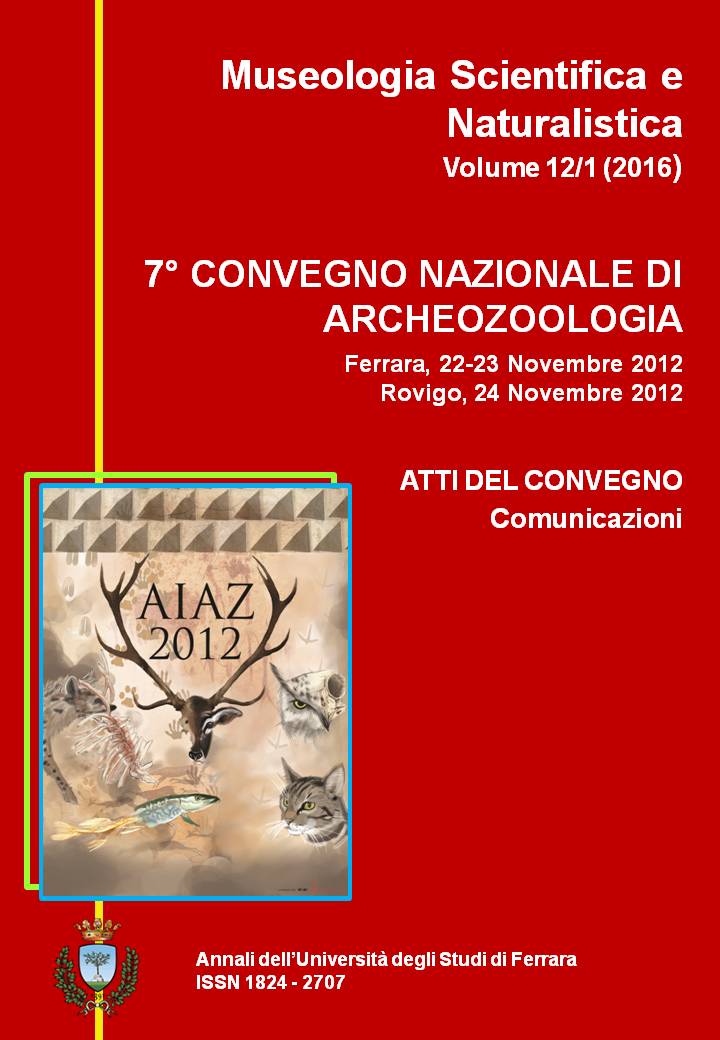I resti faunistici riferiti al I sec. d.C. del settore a Est del Tempio C di Grumentum (Grumento Nova, Potenza)
DOI:
https://doi.org/10.15160/1824-2707/1315Abstract
Riassunto - Il sito romano di Grumentum (Basilicata, Italia meridionale) è oggetto d’indagini archeologiche dal 2005 a cura dell’Università di Verona d’intesa con la Soprintendenza per i Beni Archeologici della Basilicata. Il settore di scavo ubicato lungo il lato sud-orientale del Tempio C ha restituito una sequenza di vita inquadrabile tra il II secolo a.C. e il V secolo d.C. In questo settore sono stati recuperati nel corso degli scavi archeologici circa 5000 resti di vertebrati (oltre il 41% determinati).
Nella presente nota sono esposti i dati preliminari relativi a circa 1700 resti faunistici rinvenuti nelle UUSS 665, 674 e 371 sovrastanti il battuto pavimentale USR 375 dell’Ambiente A, riferibili alla prima metà del I sec. d.C. La prima analisi di questi reperti mostra come nell’alimentazione di Grumentum durante la prima età imperiale il consumo di carne di animali domestici avesse una grande importanza, mentre la cacciagione era marginale. Inoltre, la presenza di resti di cane, di neonati e giovanissimi maiali e pecore/capre, di giovani bovini, di resti in connessione anatomica o di elementi scheletrici alquanto rari in contesti abitativi, insieme ad altre evidenze archeologiche, suggeriscono che la fase analizzata possa essere riferita a un contesto di tipo rituale.
Summary – The faunal remains referred to the 1st century AD from the eastern area of Temple C of Grumentum (Grumento Nova, Potenza)
Since 2005 the Roman archaeological site of Grumentum (Basilicata, Southern Italy) has been excavated by the University of Verona in collaboration with the “Soprintendenza per i Beni Archeologici della Basilicata”. The area is located along the southern-east side of Temple C and yielded a stratigraphical sequence from the 2nd century BC to the 5th century AD. About 5000 vertebrate remains were analyzed from the eastern area, and more than 41% of these remains have been identified.
The paper discusses the preliminary results on the faunal remains (about 1700) from the SUs 665, 674, and 371 (overlying the beaten-earth floor, SUR 375) brought to light in the “Ambiente A”. These SUs are dated to the first half of the 1st century AD. The analysis shows that animal husbandry played an important role in the alimentation during the first imperial age, whereas hunting was marginal. Moreover, together with other archaeological evidences, the occurrence of dog as well as of several very young individuals of sheep and/or goat, pig and cattle, and the presence of partial skeletons, that are rarely found in domestic buildings, suggest that these SUs can be probably related to a ritual context.



